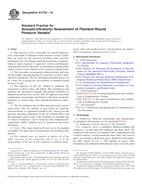Potřebujeme váš souhlas k využití jednotlivých dat, aby se vám mimo jiné mohly ukazovat informace týkající se vašich zájmů. Souhlas udělíte kliknutím na tlačítko „OK“.
ASTM E1736-10
Standard Practice for Acousto-Ultrasonic Assessment of Filament-Wound Pressure Vessels
Automaticky přeložený název:
Standardní praktiky pro Acousto-Ultrazvuková Vyhodnocení vláknité ran tlakových nádobách
NORMA vydána dne 1.6.2010
Informace o normě:
Označení normy: ASTM E1736-10
Poznámka: NEPLATNÁ
Datum vydání normy: 1.6.2010
Kód zboží: NS-42833
Počet stran: 6
Přibližná hmotnost: 18 g (0.04 liber)
Země: Americká technická norma
Kategorie: Technické normy ASTM
Anotace textu normy ASTM E1736-10 :
Keywords:
acoustic emission, acousto-ultrasonics, fiber reinforced composites, filament-wound pressure vessels, nondestructive evaluation, nondestructive testing, Pressure vessels, Acoustic emission (AE) testing, Acousto-ultrasonic (AU) method, Composites, Fiber-reinforced composites, Filament-wound pressure vessels, Nondestructive evaluation (NDE), Pressure vessel plastic, Ultrasonic testing, ICS Number Code 19.100 (Non-destructive testing)
Doplňující informace
| Significance and Use | ||||||||||||||||||
|
The AU method should be considered for vessels that are proven to be free of major flaws or discontinuities as determined by conventional techniques. The AU method may be used for detecting major flaws if other methods are deemed impractical. It is important to use methods such as immersion pulse-echo ultrasonics (Practice E1001) and acoustic emission (Practice E1067) to ascertain the presence of major flaws before proceeding with AU. The AU method is intended almost exclusively for materials characterization by assessing the collective effects of dispersed defects and subcritical flaw populations. These are material aberrations that influence AU measurements and also underlie mechanical property variations, dynamic load response, and impact and fracture resistance. The AU method can be used to evaluate laminate quality using access to only one surface, the usual constraint imposed by closed pressure vessels. For best results, the AU probes must be fixtured to maintain the probe orientation at normal incidence to the curved surface of the vessel. Given these constraints, this practice describes a procedure for automated AU scanning using water squirters to assess the serviceability and reliability of filament-wound pressure vessels. |
||||||||||||||||||
| 1. Scope | ||||||||||||||||||
|
1.1 This practice covers a procedure for acousto-ultrasonic (AU) assessment of filament-wound pressure vessels. Guidelines are given for the detection of defect states and flaw populations that arise during materials processing or manufacturing or upon exposure to aggressive service environments. Although this practice describes an automated scanning mode, similar results can be obtained with a manual scanning mode. 1.2 This procedure recommends technical details and rules for the reliable and reproducible AU detection of defect states and flaw populations. The AU procedure described herein can be a basis for assessing the serviceability of filament-wound pressure vessels. 1.3 The objective of the AU method is primarily the assessment of defect states and diffuse flaw populations that influence the mechanical strength and ultimate reliability of filament-wound pressure vessels. The AU approach and probe configuration are designed specifically to determine composite properties in lateral rather than through-the-thickness directions. 1.4 The AU method is not for flaw detection in the conventional sense. The AU method is most useful for materials characterization, as explained in Guide E1495, which gives the rationale and basic technology for the AU method. Flaws and discontinuities such as large voids, disbonds, or extended lack of contact of interfaces can be found by other nondestructive examination (NDE) methods such as immersion pulse-echo ultrasonics. 1.5 Units—The values stated in SI units are to be regarded as standard. No other units of measurement are included in this practice. 1.6 This standard does not purport to address all of the safety concerns, if any, associated with its use. It is the responsibility of the user of this standard to establish appropriate safety and health practices and determine the applicability of regulatory limitations prior to use. |
||||||||||||||||||
| 2. Referenced Documents | ||||||||||||||||||
|
Doporučujeme:
Aktualizace zákonů
Chcete mít jistotu o platnosti užívaných předpisů?
Nabízíme Vám řešení, abyste mohli používat stále platné (aktuální) legislativní předpisy.
Chcete vědět více informací? Podívejte se na tuto stránku.




 Cookies
Cookies
